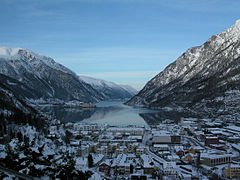Odda (town)
Odda | |
|---|---|
Ullensvang Municipality | |
| Established as | |
| By (town) | 2004 |
| Area | |
| • Total | 2.82 km2 (1.09 sq mi) |
| Elevation | 3 m (10 ft) |
| Population (2019)[1] | |
| • Total | 4,876 |
| • Density | 1,729/km2 (4,480/sq mi) |
| Demonym | Odding |
| Time zone | UTC+01:00 (CET) |
| • Summer (DST) | UTC+02:00 (CEST) |
| Post Code | 5750 Odda |
The 2.82-square-kilometre (700-acre) town has a population (2019) of 4,876 and a population density of 1,729 inhabitants per square kilometre (4,480/sq mi).[1] The town also includes the Eitrheim area, just northwest of the town centre.[4] Odda Church is located in the town centre. Norwegian National Road 13 is the main road going through the town.
History
Odda has been populated for centuries, but in the 19th century, Odda became a significant tourist destination, and it was the centre of
The present Odda is a modern town which grew up around
The
On 1 January 2020,
Notable people
Dialect
The town of Odda grew up around this smelter in the early-twentieth century, drawing migrants from different parts of Norway. As a result, there developed a new dialect, a mixture of that spoken in the home regions of the migrants—a phenomenon termed by linguists "a Koiné language". Odda and the neighboring village of Tyssedal provided valuable insights to linguists studying this phenomenon. The researcher Paul Kerswill conducted an intensive study of the Norwegian spoken in the two communities, relating them to very different geographical origins: The workers in Odda came predominantly (86%) from western Norway. In Tyssedal only about one third came from western Norway; one third came from eastern Norway; and the rest from other parts of the country. The dialects that evolved in these two communities were radically different from each other, though spoken at a short geographical distance from each other.
Media gallery
-
Aerial view, looking south. The fjord is on the bottom of the picture, then the town, then the lake Sandvinvatnet at the top. The snow-covered mountains surround the town.
-
View of the town in February 2004
-
View of the Odda smelting factory
-
View of the town in the 1950s
-
View of the harbour (c. 1895)
See also
References
- ^ a b c Statistisk sentralbyrå (1 January 2019). "Urban settlements. Population and area, by municipality".
- ^ "Odda, Ullensvang (Vestland)". yr.no. Archived from the original on 2020-03-04. Retrieved 2020-03-03.
- Store norske leksikon. "Odda – tettstedet"(in Norwegian). Retrieved 2014-06-14.
- ^ Statistisk sentralbyrå (1 January 2013). "Urban settlements. Population and area, by municipality".
- JSTOR 2560975.
- ^ "Rjukan/Notodden and Odda/Tyssedal Industrial Heritage Sites, Hydro Electrical Powered Heavy Industries with associated Urban Settlements (Company Towns) and Transportation System". UNESCO. Retrieved 2010-06-29.
- ^ Torpey, Paul (3 October 2007). "Industrial revolution". The Guardian. London. Retrieved 2012-11-19.
- ^ Riksantikvaren, Taming the Waterfalls Archived 2014-02-22 at the Wayback Machine, , Retrieved 2014-02-05.






